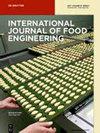Physicochemical properties, the digestible and resistant starch content of chestnut flour with different particle sizes
IF 1.6
4区 农林科学
引用次数: 0
Abstract
In this study, chestnuts were processed into flour, and the obtained chestnut flour (CF) was passed through a sieve with an aperture size of 212 µm. Then the physicochemical properties, digestible and resistant starch contents of CF1 (<212 µm), CF2 (≥212 µm), and commercial chestnut flour (CCF) were determined. It was found that CCF had the highest values in terms of proximate composition, total soluble polyphenol content (891.25 mg GAE/100 g), and antioxidant activity (ABTS: 1552.11 mg TE/100 g, DPPH: 2003.01 mg TE/100 g). On the other hand, CF1 was superior in terms of resistant starch content (39.31 g/100 g, dw) (p < 0.05). The resistant starch content of CF1 was approximately 1.5-fold and 3-fold higher than CCF and CF2, respectively. Furthermore, the rapidly digestible starch content of CF1 (2.1 g/100 g, dw) and CF2 (0.93 g/100 g, dw) was quite lower than CCF (12.64 g/100 g, dw) (p < 0.05). Moreover, CF1 exhibited lower (p < 0.05) water, alkaline water, and sodium carbonate retention capacities, which make it a potential good flour for cookie and cracker production. In contrast, CF2 could be evaluated as a good ingredient for noodle-type foods due to its lower water solubility index. Considering the least gelation concentrations of samples, it was seen that CF1 (% 10) could also be valorized as a thickening or gelation agent in the food industry, as well as CCF (% 6).不同粒径栗子粉的理化特性、可消化淀粉和抗性淀粉含量
在这项研究中,栗子被加工成面粉,得到的栗子粉(CF)通过孔径为 212 µm 的筛子。然后测定了 CF1(<212 µm)、CF2(≥212 µm)和商品栗子粉(CCF)的理化性质、可消化淀粉和抗性淀粉含量。结果发现,CCF 在近似成分、总可溶性多酚含量(891.25 毫克 GAE/100 克)和抗氧化活性(ABTS:1552.11 毫克 TE/100 克,DPPH:2003.01 毫克 TE/100 克)方面的值最高。另一方面,CF1 在抗性淀粉含量(39.31 克/100 克,干重)方面更胜一筹(p < 0.05)。CF1 的抗性淀粉含量分别比 CCF 和 CF2 高出约 1.5 倍和 3 倍。此外,CF1(2.1 克/100 克干重)和 CF2(0.93 克/100 克干重)的快速消化淀粉含量大大低于 CCF(12.64 克/100 克干重)(p < 0.05)。此外,CF1 的水分、碱水和碳酸钠保留能力较低 (p < 0.05),因此有可能成为饼干和薄脆饼干生产的优质面粉。相比之下,CF2 的水溶性指数较低,可作为面条类食品的良好配料。考虑到样品的凝胶化浓度最低,CF1(10%)和 CCF(6%)也可作为食品工业中的增稠剂或凝胶剂。
本文章由计算机程序翻译,如有差异,请以英文原文为准。
求助全文
约1分钟内获得全文
求助全文
来源期刊
CiteScore
3.20
自引率
0.00%
发文量
52
审稿时长
3.8 months
期刊介绍:
International Journal of Food Engineering is devoted to engineering disciplines related to processing foods. The areas of interest include heat, mass transfer and fluid flow in food processing; food microstructure development and characterization; application of artificial intelligence in food engineering research and in industry; food biotechnology; and mathematical modeling and software development for food processing purposes. Authors and editors come from top engineering programs around the world: the U.S., Canada, the U.K., and Western Europe, but also South America, Asia, Africa, and the Middle East.

 求助内容:
求助内容: 应助结果提醒方式:
应助结果提醒方式:


